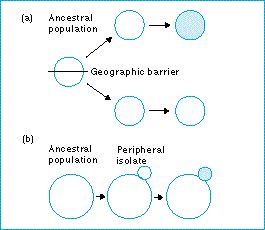Rates of evolution - What is punctuated equilibrium?

The theory of punctuated equilibrium has developed
The original model of punctuated equilibrium attributed the rapid change at speciation to allopatric events, in peripheral isolates. A number of suggestions have been made about how evolution might happen in a small peripherally isolated population:
• Evolution proceeds as normal, under selection and drift which is enough to generate the punctuated equilibrial pattern.
• The peripherally isolated population may evolve in an abnormal manner, because it may be living under abnormal conditions. Stabilizing selection favors the evolution of homeostatic mechanisms: under extreme conditions these mechanisms may break down and an unusual array of phenotypes may then be expressed. Of course new genotypes would be needed for permanent evolutionary effect but perhaps genetic variation that was previously disguised by homeostatic mechanisms could be expressed in the new conditions.
• Major evolutionary break-throughs could be due to macromutation. Macromutations might tend to arise in genes controlling regulatory, or developmental, processes rather than in structural genes, and new species and major groups might therefore arise by regulatory macromutation. Macroevolution would then proceed by non-adaptive mechanisms, and adaptive evolution would be confined to minor adjustments within populations.
The main conjecture of these hypotheses is that macro- and microevolutionary changes might be uncoupled: natural selection and ordinary variation might produce only small-scale, microevolutionary change. It is only in isolated populations under extreme conditions that radically new genotypes are formed.
Figure: two models of allopatric speciation. (a) The dumb-bell model in which the ancestor species is divided into two roughly equal halves, each of which forms a new species. (b) The peripheral isolate model, in which the new species forms from a population isolated at the edge of the ancestral species range.
| Next |



